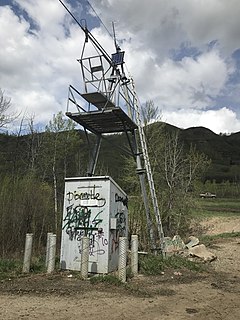
The Peace River is a 1,923-kilometre-long (1,195 mi) river in Canada that originates in the Rocky Mountains of northern British Columbia and flows to the northeast through northern Alberta. The Peace River joins the Athabasca River in the Peace-Athabasca Delta to form the Slave River, a tributary of the Mackenzie River. The Finlay River, the main headwater of the Peace River, is regarded as the ultimate source of the Mackenzie River. The combined Finlay–Peace–Slave–Mackenzie river system is the 13th longest river system in the world.

The Beatton River is a tributary of the Peace River, flowing generally east, then south through north-eastern British Columbia, Canada. The river rises at Pink Mountain, about 10 kilometres (6 mi) west of the Alaska Highway hamlet of the same name, and flows 240 kilometres (150 mi) generally east, then south, draining into the Peace River just downstream of Fort St. John. The river meanders mostly through the boreal forest and muskeg of the Peace Plain. Its major tributaries are the Doig and Blueberry Rivers.

Bear Glacier Provincial Park is a provincial park in British Columbia, Canada. The park is 542 ha in size and was established, effective 11 May 2000, by the Nisga'a Treaty, Appendix G-3.

Beatton Provincial Park is a provincial park in the Peace River Country of northeastern British Columbia, Canada.
Bull Canyon Provincial Park is a provincial park in British Columbia, Canada, protecting Bull Canyon on the Chilcotin River, which is 7 km (4 mi) below the confluence of the Chilko River with the Chilcotin. The canyon and park are located just west of the community of Alexis Creek. Bull Canyon is part of a large volcanic plateau called the Chilcotin Group.
Conkle Lake Provincial Park is a provincial park in British Columbia, Canada, located west of the confluence of the Kettle and West Kettle Rivers. The park size is 587 hectares.
Charlie Lake Provincial Park is a provincial park in British Columbia, Canada, established on the western shore of Charlie Lake. It is roughly 92 hectares in size.

North Thompson River Provincial Park is a provincial park in British Columbia, Canada.
Upper Violet Creek Provincial Park is a provincial park in British Columbia, Canada.
Peace River Corridor Provincial Park is a 2014 ha provincial park in British Columbia, Canada.
Pennask Lake Provincial Park is a provincial park in British Columbia, Canada, located on the easternmost heights of the Thompson Plateau,50 km (31 mi) to the northwest of the Okanagan town of Peachland.

Rebecca Spit Marine Provincial Park is a provincial park in British Columbia, Canada, located on the east side of Quadra Island, near the city of Campbell River.
Taylor Landing Provincial Park is a provincial park in British Columbia, Canada.
Truman Dagnus Locheed Provincial Park is a former provincial park in British Columbia, Canada, located on the northeast side of Okanagan Lake to the southwest of the city of Vernon. It was transferred to ownership by the town of Vernon in March 2013.
The Blueberry River is a river in the Peace River Block of northeastern British Columbia, Canada. It is a tributary of the Beatton River, which is a tributary of the Peace River.
Wedge Pass, also known as Billygoat Pass, 1430 m (4692 ft), is a mountain pass in the northern Garibaldi Ranges, the southwesternmost subdivisions of the Pacific Ranges of the Coast Mountains in British Columbia, Canada. Located immediately on the southern flank of Wedge Mountain and to the immediate north of the Spearhead Range, site of the Blackcomb half of the Whistler Blackcomb Ski Area, it connects the head of Wedge Creek (W), a tributary of the Green River with those of Billgoat Creek (E), a tributary of the Lillooet River. The pass is within Garibaldi Provincial Park and has no road access.

Bush River is a tidal estuary in Harford County, Maryland, located about 15 mi (24 km) northeast of Baltimore. The estuary extends from the community of Riverside, south for about 9 mi (14 km), to the Chesapeake Bay. The watershed area of tidal Bush River is 125 mi2 (320 km2), and includes Aberdeen Proving Ground, a military facility.

Charlie Lake is a lake in north-eastern British Columbia, Canada, situated 8 km (5.0 mi) west from Fort St. John, along the Alaska Highway. The lake provides the water supply for the city of Fort St. John. The Charlie Lake Formation, a stratigraphical unit of the Western Canadian Sedimentary Basin is named for the lake.
Manitoba's Swan-Pelican Provincial Forest lies just west of Lake Winnipegosis, and is named for the two smaller lakes in the area, Swan Lake and Pelican Lake. The forest has an area of 3,705 km2, and is the second-largest provincial forest in Manitoba. Most of the forest is located within the unorganized portion of Census Division No. 19, but its southernmost reaches extend into the Rural Municipality of Mountain (South). A fairly newly established forest, it was not officially recognized as a provincial forest until 1987.
Stinking Creek is a stream in northern Polk County in the U.S. state of Missouri. It is a tributary of the Pomme de Terre River. The stream headwaters are along Missouri Route D between Polk and Huron. The stream flows north-northwest and enters the southern end of Pomme de Terre Lake just west of Adonis.








